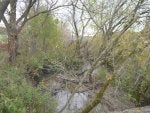There is a Driftless area tour every year that is free. I think it is sponsored by TU and DARE (Driftless Area Restoration Effort).
Driftless Area Restoration Effort | Trout Unlimited
Driftless Area Restoration Effort
Driftless Area Restoration Effort | National Fish Habitat Partnership
I took the tour two weeks ago and I visited 4 streams in Southwestern, Wi. Other years have visited the Minnesota Driftless areas and the Driftless area in Iowa.
I learned a lot about how they rehab streams now that is different from how they used to. They don't use "lunker structures" any more. They remove all trees for about 100 feet on each side of the stream. Then they dig away the dirt so they can lay down rock slabs for those 100 feet on each side. They cover that with dirt and seed it with natural grass cover seed.
Here is the stream on the side of the stream which has not been rehabbed. Note the overgrown vegetation and the trees.

Here is the other side which has had the trees removed and the stream rehabbed. The put flat rock slabs into the sides of the stream opposite each other. These blocks of stone are high and wide enough to be anchored into both the sides and bottom of the stream. There is also a stone slab at the bottom under these rock slabs. Imagine a stream the is narrowed on each side with a stone chute in the middle. Note that the DNR rep is standing on the rock chute.

Note the rock blocks anchored to each side in the image below. You get a better sense of the size of the blocks and the anchoring into the stream bank. The water shoots through this chute and over the stone bottom and cuts a deep hole on the downstream side. Since the stone is anchored on each side at the same level as the 100 feet of stone on each side of the stream, even if the river overflows; this does structure does NOT wash out nor can the overflow cut a path around the stone chute.

What this does is protect the stream from being washed out by floods. The edges of the stream at the curves are rip rapped so there is nothing to get "blown out." When the stream overflows, it is protected 100 feet on each side. The vegetation keeps the topsoil from being eroded from the underlying rock.
They put flat rock slabs into the sides of the stream opposite each other. These blocks of stone are high and wide enough to be anchored into both the sides and bottom of the stream. There is also a stone slab at the bottom under these rock slabs. Imagine a stream the is narrowed on each side with a stone chute in the middle.
Note that the DNR rep is standing on the rock chute in the image above
The trees that were along the stream are taken down and the root balls are pulled out. The root balls are used to provide in stream cover. Sometimes the stump is inserted into the stream bank with the root ball sticking out from the bank. Other times the the root ball is inserted and the stump sticks out. Sometimes the root ball is place into the stream bottom. All of these "projections" change the water flow so the stream itself carves out deep holes that form holding areas BENEATH the stump or root ball and the stump or root ball forms the overhead cover.
The photo below is of an ongoing project In the photo below, root balls have been put into the stream bottom. You can see the tops of two root balls. Note the straw covering the seeded banks.

Below is a photo of the a stump and root ball with the root ball buried in the bank of the stream.

Since I can only attach 5 photos per post, the rest of the description of the tour is in the next post.








